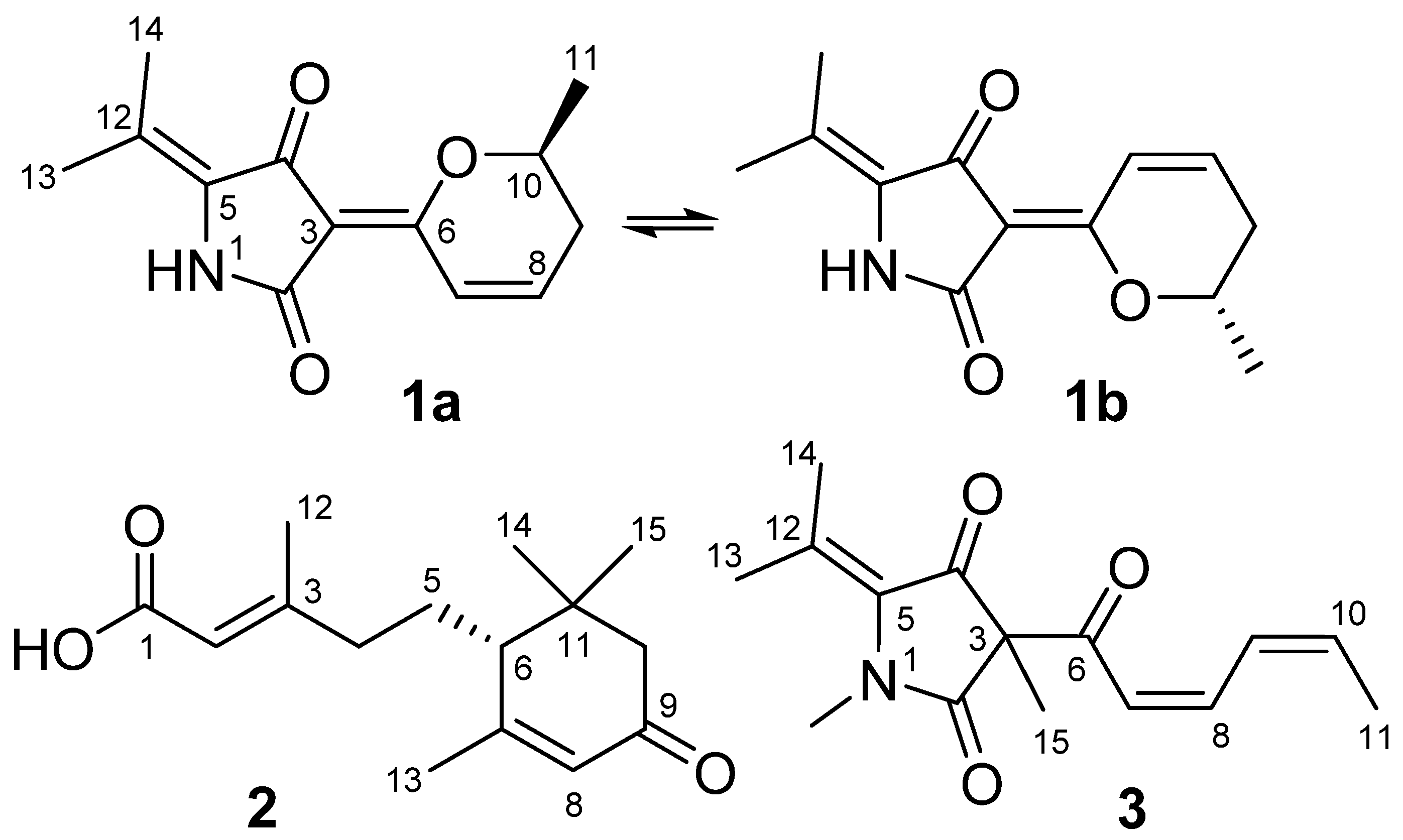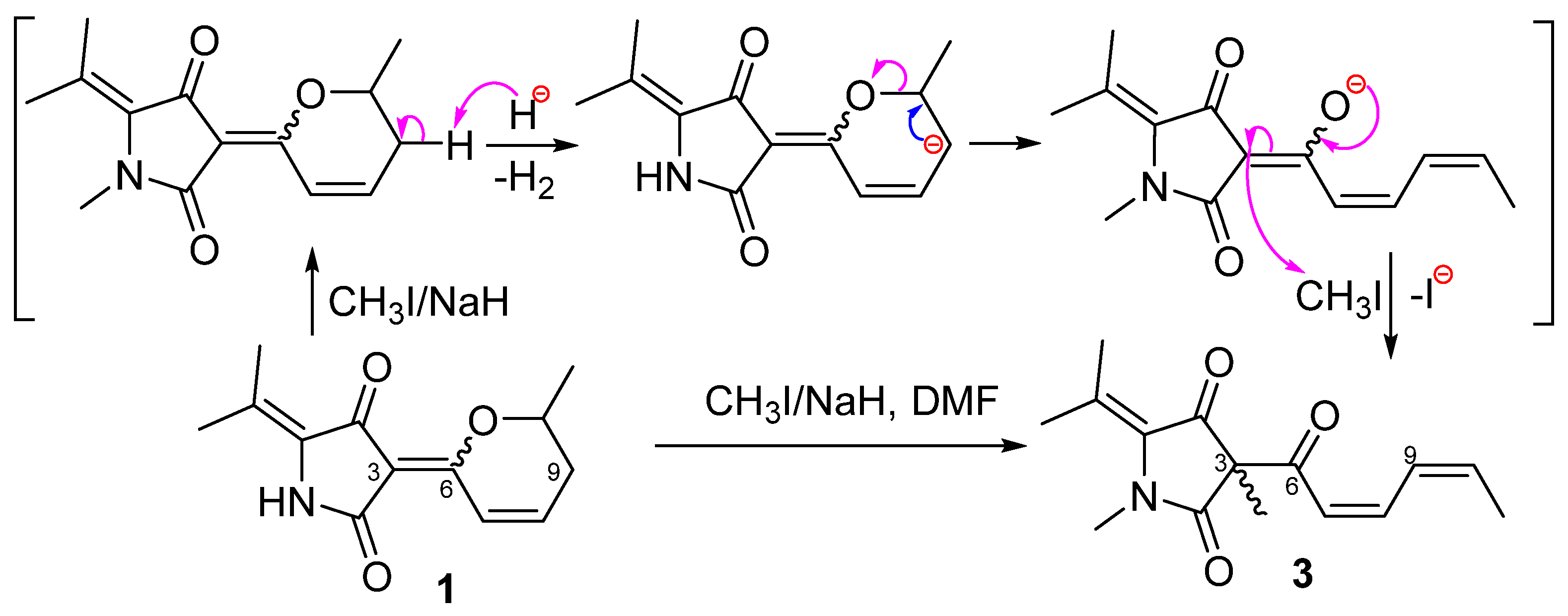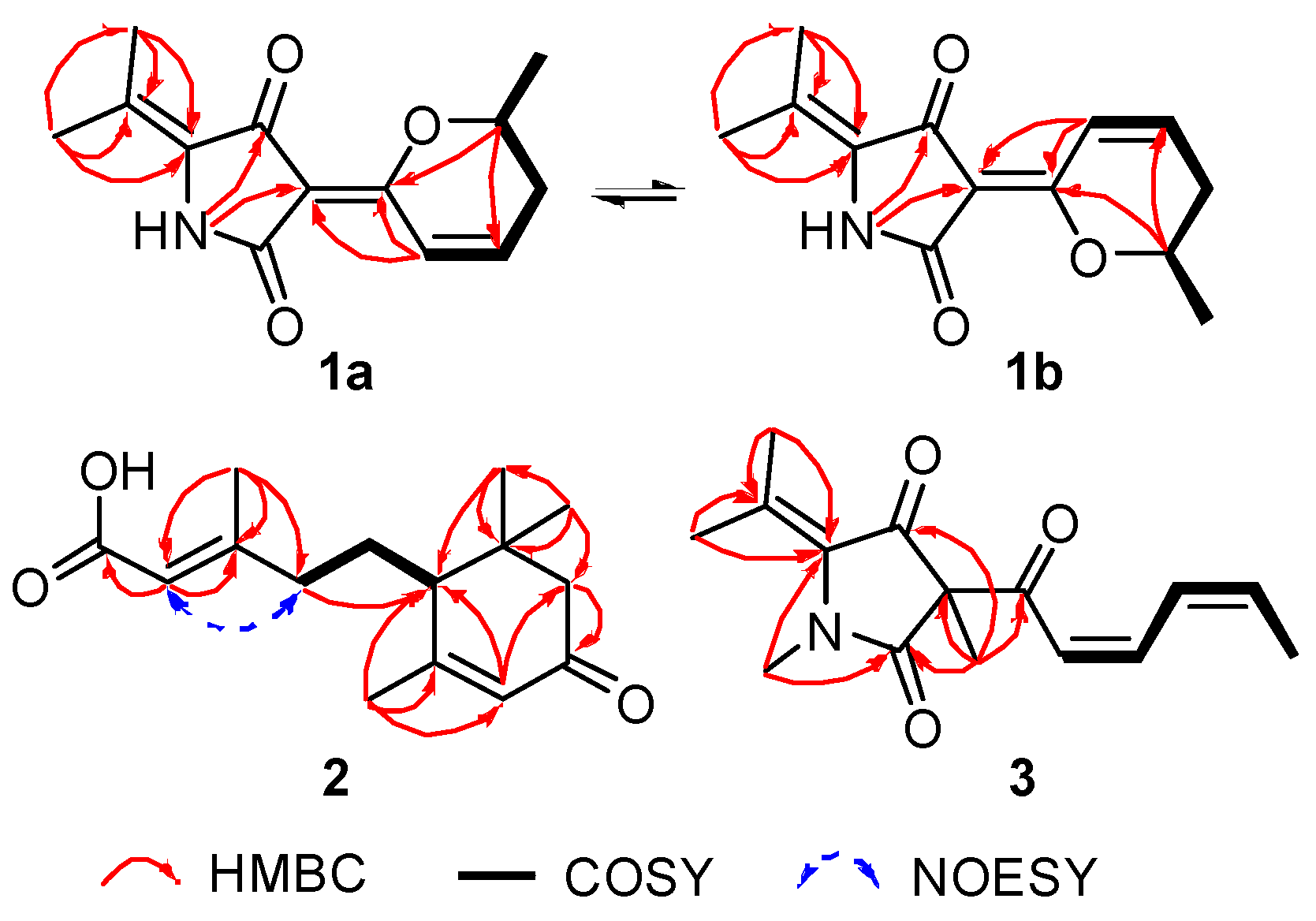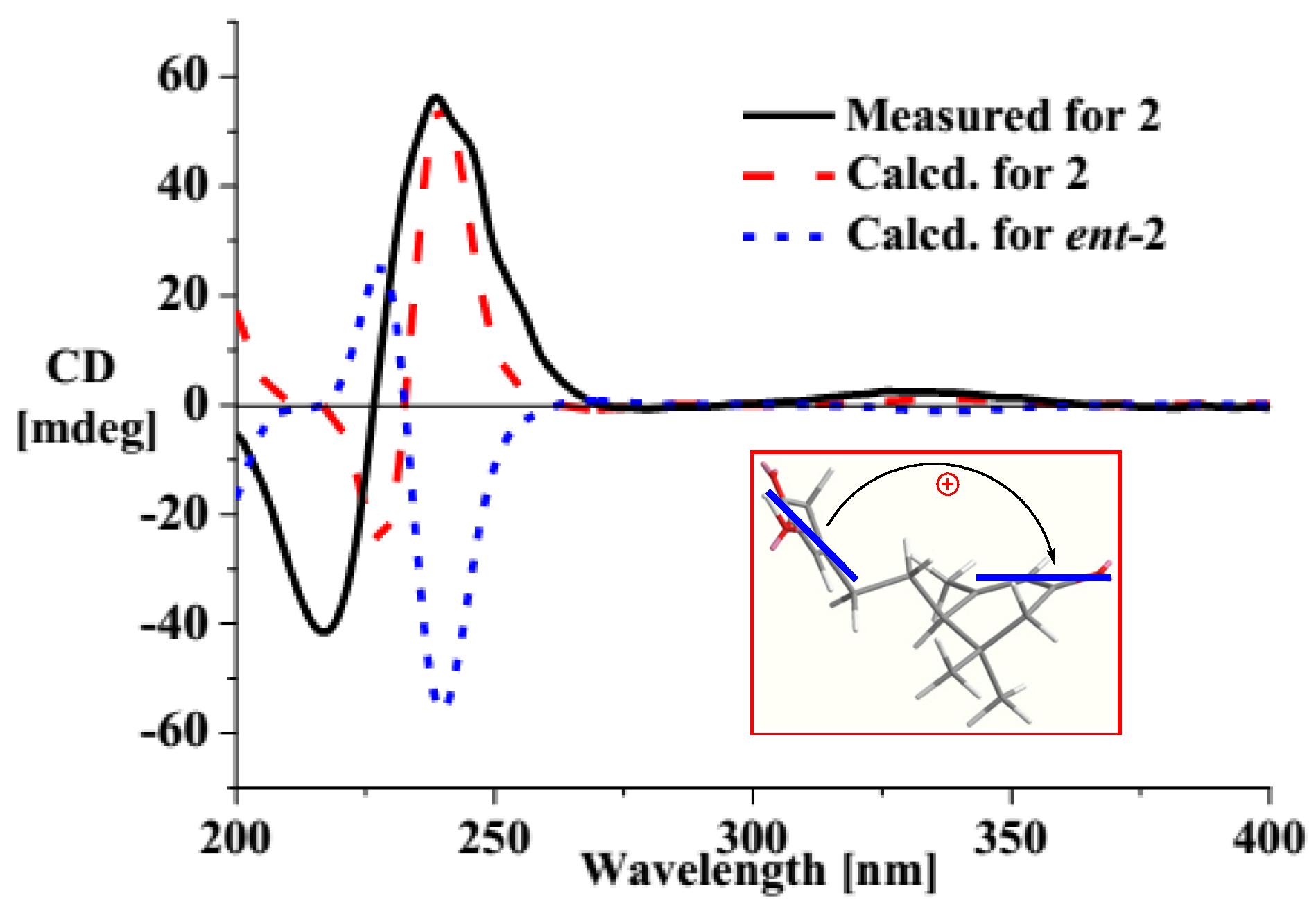Cladodionen, a Cytotoxic Hybrid Polyketide from the Marine-Derived Cladosporium sp. OUCMDZ-1635
Abstract
:1. Introduction
2. Results and Discussion
2.1. Structure Elucidation
2.2. The Bioactivities of Compounds 1–3 from Cladosporium sp. OUCMDZ-1635.
3. Experimental Section
3.1. General Experimental Procedures
3.2. Collection and Phylogenetic Analysis of Strain OUCMDZ-1635
3.3. Cultivation and Extraction of OUCMDZ-1635
3.4. Purification
3.5. Preparation of 3
4. Conclusions
Supplementary Materials
Acknowledgments
Author Contributions
Conflicts of Interest
References
- Bernan, V.S.; Greenstein, M.; Maiese, W.M. Marine microorganisms as a source of new natural products. Adv. Appl. Microbiol. 1997, 43, 57–90. [Google Scholar] [PubMed]
- Newman, D.J.; Hill, R.T. New drugs from marine microbes: The tide is turning. J. Ind. Microbiol. Biotechnol. 2006, 33, 539–544. [Google Scholar] [CrossRef] [PubMed]
- Baharum, S.N.; Beng, E.K.; Mokhtar, M.A.A. Marine microorganisms: Potential application and challenges. J. Biol. Sci. 2010, 10, 555–564. [Google Scholar] [CrossRef]
- Corinaldesi, C.; Barone, G.; Marcellini, F.; Dell’Anno, A.; Danovaro, R. Marine microbial-derived molecules and their potential use in cosmeceutical and cosmetic products. Mar. Drugs 2017, 15, 118. [Google Scholar] [CrossRef] [PubMed]
- Bugni, T.S.; Ireland, C.M. Marine-derived fungi: A chemically and biologically diverse group of microorganisms. Nat. Prod. Rep. 2004, 21, 143–163. [Google Scholar] [CrossRef] [PubMed]
- Xu, L.; Meng, W.; Cao, C.; Wang, J.; Shan, W.; Wang, Q. Antibacterial and antifungal compounds from marine fungi. Mar. Drugs 2015, 13, 3479–3513. [Google Scholar] [CrossRef] [PubMed]
- Gomes, N.G.M.; Lefranc, F.; Kejjoa, A.; Kiss, R. Can some marine-derived fungal metabolites become actual anticancer agents? Mar. Drugs 2015, 13, 3950–3991. [Google Scholar] [CrossRef] [PubMed]
- Saleem, M.; Ali, M.S.; Hussain, S.; Jabbar, A.; Ashraf, M.; Lee, Y.S. Marine natural products of fungal origin. Nat. Prod. Rep. 2007, 24, 1142–1152. [Google Scholar] [CrossRef] [PubMed]
- Rateb, M.E.; Ebel, R. Secondary metabolites of fungi from marine habitats. Nat. Prod. Rep. 2011, 28, 290–344. [Google Scholar] [CrossRef] [PubMed]
- Zheng, J.; Zhu, H.; Hong, K.; Wang, Y.; Liu, P.; Wang, X.; Peng, X.; Zhu, W. Novel cyclic hexapeptides from marine-derived fungus, Aspergillus sclerotiorum PT06-1. Org. Lett. 2009, 11, 5262–5265. [Google Scholar] [CrossRef] [PubMed]
- Zhuang, Y.; Teng, X.; Wang, Y.; Liu, P.; Li, G.; Zhu, W. New quinazolinone alkaloids within rare amino acid residue from coral-associated fungus, Aspergillus versicolor LCJ-5-4. Org. Lett. 2011, 13, 1130–1133. [Google Scholar] [CrossRef] [PubMed]
- Fan, Y.; Wang, Y.; Liu, P.; Fu, P.; Zhu, T.; Wang, W.; Zhu, W. Indole-diterpenoids with anti-h1n1 activity from the aciduric fungus Penicillium camemberti OUCMDZ-1492. J. Nat. Prod. 2013, 76, 1328–1336. [Google Scholar] [CrossRef] [PubMed]
- Kong, F.; Wang, Y.; Liu, P.; Dong, T.; Zhu, W. Thiodiketopiperazines from the marine-derived fungus Phoma sp. OUCMDZ-1847. J. Nat. Prod. 2014, 77, 132–137. [Google Scholar] [CrossRef] [PubMed]
- Shu, Y.-Z.; Ye, Q.; Kolb, J.M.; Huang, S.; Veitch, J.A.; Lowe, S.E.; Manly, S.P. Bripiodionen, a new inhibitor of human cytomegalovirus protease from Streptomyces sp. WC76599. J. Nat. Prod. 1997, 60, 529–532. [Google Scholar] [CrossRef] [PubMed]
- Oritani, T.; Ichimura, M.; Yamashita, K. The metabolism of analogs of abscisic acid in Cercospora cruenta. Agric. Biol. Chem. 1982, 46, 1959–1960. [Google Scholar] [CrossRef]
- Hosoe, T.; Fukushima, K.; Takizawa, K.; Itabashi, T.; Yoza, K.; Kawai, K. A new pyrrolidine-2,4-dione derivative, vermelhotin, isolated from unidentified fungus IFM 52672. Heterocycles 2006, 68, 1949–1953. [Google Scholar]
- Kuhnert, E.; Heitkamper, S.; Fournier, J.; Surup, F.; Stadler, M. Hypoxyvermelhotins A–C, new pigments from Hypoxylon lechatii sp. Nov. Fungal Biol. 2014, 118, 242–252. [Google Scholar] [CrossRef] [PubMed]
- Boettger, D.; Hertweck, C. Molecular diversity sculpted by fungal PKS-NRPS hybrids. ChemBioChem 2013, 14, 28–42. [Google Scholar] [CrossRef] [PubMed]
- Ishida, A.; Mukaiyama, T. A new method for the preparation of δ-alkoxy-α,β-unsaturated aldehydes and polyenals. Bull. Chem. Soc. Jpn. 1977, 50, 1161–1168. [Google Scholar] [CrossRef]
- Stephens, P.J.; Pan, J.J.; Krohn, K.J. Determination of the absolute configurations of pharmacological natural products via density functional theory calculations of vibrational circular dichroism: The new cytotoxic iridoid prismatomerin. J. Org. Chem. 2007, 72, 7641–7649. [Google Scholar] [CrossRef] [PubMed]
- Liu, Y.; Cheng, Y.; Liaw, C.; Chen, C.; Guh, J.; Hwang, T.; Tsai, J.; Wang, W.; Shen, Y. Bioactive diterpenes from Callicarpa longissima. J. Nat. Prod. 2012, 75, 689–693. [Google Scholar] [CrossRef] [PubMed]
- Pan, L.; Acuña, U.M.; Li, J.; Jena, N.; Ninh, T.N.; Pannell, C.M.; Chai, H.; Fuchs, J.R.; de Blanco, E.J.C.; Soejarto, D.D.; et al. Bioactive flavaglines and other constituents isolated from Aglaia perviridis. J. Nat. Prod. 2013, 76, 394–404. [Google Scholar] [CrossRef] [PubMed]
- Harada, N.; Nakanishi, K. Circular Dichroic Spectroscopy-Exciton Coupling in Organic Stereochemistry; University Scienc Books: Mill Valley, CA, USA, 1983. [Google Scholar]
- Harada, N. Absolute configuration of (+)-trans-abscisic acid as determined by a quantitative application of the exciton chirality method. J. Am. Chem. Soc. 1973, 95, 240–242. [Google Scholar] [CrossRef]





| No. | 1a a | 1b a | 2 b | 3 c | ||||
|---|---|---|---|---|---|---|---|---|
| δC | δH, Mult. (J in Hz) | δC | δH, Mult. (J in Hz) | δC | δH, Mult. (J in Hz) | δC | δH, Mult. (J in Hz) | |
| 1 | 9.79, s | 103.1, C | 9.64, s | 161.9, C | 65.5, C | |||
| 2 | 166.4, C | 164.5, C | 115.5, CH | 5.70, s | 170.0, C | |||
| 3 | 103.2, C | 103.1, C | 161.9, C | |||||
| 4 | 183.3, C | 185.8, C | 40.9, CH2 | 2.26, t (8.0) | 194.2, C | |||
| 5 | 129.3, C | 130.0, C | 28.2, CH2 | 1.58, m; 1.89d | 131.9, C | |||
| 6 | 165.9, C | 167.5, C | 50.8, CH | 1.89d | 188.7, C | |||
| 7 | 119.9, CH | 7.70, d (9.9) | 119.9, CH | 7.67, d (9.8) | 164.6, C | 117.6, CH | 5.77, d (11.3) | |
| 8 | 143.5, CH | 6.93, m | 144.1, CH | 6.96, m | 125.6, CH | 5.85, s | 147.3, CH | 6.66, dd (11.3, 10.7) |
| 9 | 30.4, CH2 | 2.36, m; 2.56, m | 30.4, CH | 2.34, m; 2.59, m | 199.2, C | 128.7, CH | 7.22, dd (10.7, 10.3) | |
| 10 | 73.4, CH | 4.41, m | 73.4, CH | 4.41, m | 47.3, CH2 | 2.06, d (17.1); 2.37, d (17.1) | 145.5, CH | 6.34, dq (10.3, 6.8) |
| 11 | 20.1, CH3 | 1.39, d (6.0) | 20.1, CH3 | 1.39, d (6.0) | 36.5, C | 18.8, CH3 | 1.85, d (6.8) | |
| 12 | 118.4, C | 118.8, C | 19.3, CH3 | 2.18, s | 127.7, C | |||
| 13 | 20.8, CH3 | 1.74, s | 20.9, CH3 | 1.74, s | 24.8, CH3 | 1.99, s | 21.8, CH3 | 2.13, s |
| 14 | 18.2, CH3 | 2.10, s | 17.9, CH3 | 2.11, s | 27.3, CH3 | 1.08, s | 21.4, CH3 | 2.19, s |
| 15 | 28.9, CH3 | 1.03, s | 15.3, CH3 | 1.30, s | ||||
© 2018 by the authors. Licensee MDPI, Basel, Switzerland. This article is an open access article distributed under the terms and conditions of the Creative Commons Attribution (CC BY) license (http://creativecommons.org/licenses/by/4.0/).
Share and Cite
Zhu, G.; Kong, F.; Wang, Y.; Fu, P.; Zhu, W. Cladodionen, a Cytotoxic Hybrid Polyketide from the Marine-Derived Cladosporium sp. OUCMDZ-1635. Mar. Drugs 2018, 16, 71. https://doi.org/10.3390/md16020071
Zhu G, Kong F, Wang Y, Fu P, Zhu W. Cladodionen, a Cytotoxic Hybrid Polyketide from the Marine-Derived Cladosporium sp. OUCMDZ-1635. Marine Drugs. 2018; 16(2):71. https://doi.org/10.3390/md16020071
Chicago/Turabian StyleZhu, Guoliang, Fandong Kong, Yi Wang, Peng Fu, and Weiming Zhu. 2018. "Cladodionen, a Cytotoxic Hybrid Polyketide from the Marine-Derived Cladosporium sp. OUCMDZ-1635" Marine Drugs 16, no. 2: 71. https://doi.org/10.3390/md16020071




